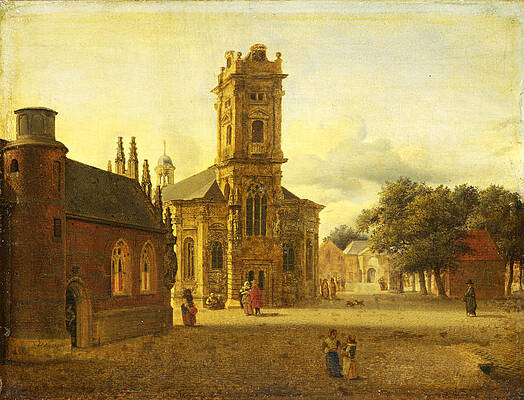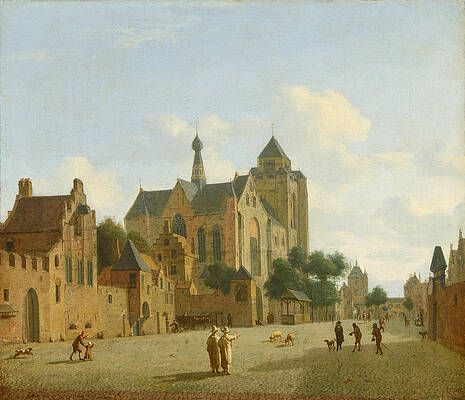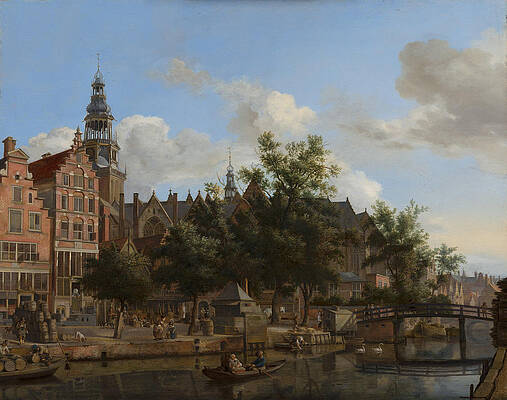Jan van der Heyden
Paintings
View of the Westerkerk Amsterdam
View of Goudestein with a Woman and Child walking beside a Dyke
A Square before a Church
An Architectural Fantasy
An Imaginary View of Nijenrode Castle
The Huis ten Bosch at The Hague
A Farm among Trees
A View in Cologne
The Church at Veere
View of the Keizersgracht with the Westerkerk
View Down a Dutch Canal
View of Oudezijds Voorburgwal with the Oude Kerk in Amsterdam
The Hofstede Wolf en Hoeck on the Purmer
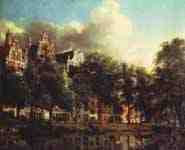
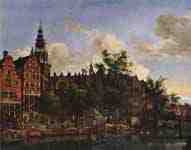
Oude-Zijds-Voorburgwal in Amsterdam
Drawings
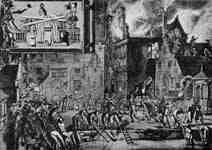
Jan van der Heyden (March 5, 1637, Gorinchem – September 12, 1712, Amsterdam) was a Dutch Baroque-era painter, draughtsman, printmaker, a mennonite and inventor who significantly contributed to contemporary firefighting. He improved the fire hose in 1672, with his brother Nicolaes, who was a hydraulic engineer. He modified the manual fire engines, reorganised the volunteer fire brigade (1685) and wrote and illustrated the first firefighting manual (Brandspuiten-boek). A comprehensive street lighting scheme for Amsterdam, which lasted from 1669 until 1840, designed and implemented by Van der Heyden, was adopted as a model by many other towns and abroad.
Jan van der Heyden (March 5, 1637, Gorinchem – September 12, 1712, Amsterdam) was a Dutch Baroque-era painter, draughtsman, printmaker, a mennonite and inventor who significantly contributed to contemporary firefighting. He improved the fire hose in 1672, with his brother Nicolaes, who was a hydraulic engineer.[1] He modified the manual fire engines, reorganised the volunteer fire brigade (1685) and wrote and illustrated the first firefighting manual (Brandspuiten-boek). A comprehensive street lighting scheme for Amsterdam, which lasted from 1669 until 1840, designed and implemented by Van der Heyden, was adopted as a model by many other towns and abroad.
Biography
Van der Heyden grew up in Gorcum, where he learned drawing from a glass painter.[2] but the family moved to Amsterdam around 1650. They lived on Dam Square. As a young man he witnessed the fire in the old townhall which made a deep impression on him. He later would describe or draw 80 fires in almost any neighborhood of Amsterdam. When he married in 1661, he lived on the most fashionable canal in Amsterdam, Herengracht. In 1668 Cosimo II de' Medici bought one of his paintings, a view of the townhall with a manipulated perspective. Van der Heyden often painted country estates, like Goudestein, owned by Joan Huydecoper II. Though he was exceptionally good at perspective, he was not good in drawing figures or details, and used for his paintings a metal plate for bricks, and a sponge or moss for the leaves. Johannes Lingelbach, Adriaen van de Velde and Eglon van der Neer assisted him by drawing the figures on his paintings. Jan van der Heyden also introduced the lamp post and in 1672 improved the design of the fire engine.
Van der Heyden was a contemporary of the landscape painters Hobbema and Jacob van Ruisdael, with the advantage, which they lacked, of a certain professional versatility; for, whilst they painted admirable pictures and starved, he varied the practice of art with the study of mechanics. Van der Heyden, who was perfect as an architectural draughtsman insofar as he painted the outside of buildings and thoroughly mastered linear perspective, seldom turned his hand to the delineation of anything but brick houses and churches in streets and squares. Until 1672 he painted in partnership with Adriaen van de Velde, who populated his architectural scenes with figures and landscape effects.[2] After Adriaen's death, he accepted the government appointment and his productivity was lower.[2] His most important works were painted in the years 1660-1670, most notably views of the Amsterdam town hall, the Amsterdam exchange, the London exchange, and views of Cologne.[2] He died in wealth as the superintendent of the lighting and director of the (voluntary) firemen's guild at Amsterdam.
He was a travelled man, had seen The Hague, Ghent and Brussels, and had ascended the Rhine past Xanten to Cologne, where he copied over and over again the tower and crane of the great cathedral. But he cared nothing for hill or vale, or stream or wood. He could reproduce the rows of bricks in a square of Dutch houses sparkling in the sun, or stunted trees and lines of dwellings varied by steeples, all in light or thrown into passing shadow by moving cloud.
Museums with van der Heyden's works
Fire hose apparatus built in 1672 and designed by Jan van der Heyden in Town hall, De Rijp
Rijksmuseum, Amsterdam, Netherlands
Musée du Louvre, Paris, France
Amsterdams Historisch Museum, Amsterdam
Mauritshuis, Royal Cabinet of Paintings, The Hague
Galleria degli Uffizi, Florence, Italy
National Gallery of Art, Washington, D.C.
Metropolitan Museum of Art, New York City, New York
Detroit Institute of Arts, Detroit, Michigan
Museum of Fine Arts, Houston, Houston, Texas
National Gallery of Armenia, Yerevan, Armenia
Exhibitions
The Bruce Museum of Arts and Science in Greenwich, Connecticut, presented "Jan van der Heyden (1637–1712)", an exhibition of works by the artist, from September 16, 2006, through January 10, 2007. The exhibit consistsed of 37 of the artist’s cityscape paintings and 16 drawings with supplemental material on Van der Heyden’s publication on firefighting. The exhibition was the first monographic exhibition of van der Heyden’s art to be mounted in 70 years and the first shown ever in the United States, according to the museum. The exhibition had its only showing in the United States at the Bruce Museum, after which it traveled (in slightly abridged form) to the Rijksmuseum in Amsterdam.[3]
References
The fire hose pump was invented by Johann Hautsch, "Jan van der Heiden". Retrieved 2007-01-15.[dead link]
(Dutch) Joan vander Heyden biography in De groote schouburgh der Nederlantsche konstschilders en schilderessen (1718) by Arnold Houbraken, courtesy of the Digital library for Dutch literature
[1] Bruce Museum Web site, Jan van der Heyden exhibit Web pages, accessed September 9, 2006
Van der Heyden, Fire Engines with Water Hoses and the Method of Fighting Fires by Lettie Stibbe Multhauf, 102 illustrated pages (Science History Publications/USA: 1996)
Jan van der Heyden (1637–1712) (exhibit catalogue) by Peter C. Sutton, et al., 50 illustrated pages, including 130 paintings, drawings and figures (Yale University Press: 2006). The book is the first publication on the artist in the English language, according to the Bruce Museum, where Sutton is director.
Public Domain This article incorporates text from a publication now in the public domain: Chisholm, Hugh, ed. (1911). Encyclopædia Britannica (11th ed.). Cambridge University Press.
----
Fine Art Prints | Greeting Cards | Phone Cases | Lifestyle | Face Masks | Men's , Women' Apparel | Home Decor ...
----
Artist
A - B - C - D - E - F - G - H - I - J - K - L - M -
N - O - P - Q - R - S - T - U - V - W - X - Y - Z
Retrieved from "http://en.wikipedia.org/"
All text is available under the terms of the GNU Free Documentation License




